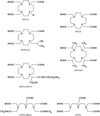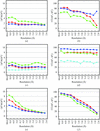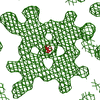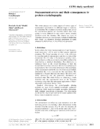issue contents
November 2003 issue
Experimental phasing
Proceedings of the CCP4 study weekend

Cover illustration: Elastase molecule showing bound iodide and polyiodides as blue spehres, p. 1923.
CCP4 study weekend
Open  access
access
 access
accessAn overview of macromolecular phasing methods for those new to structural biology.
Open  access
access
 access
accessThe application of likelihood has had a great impact on experimental phasing. New approaches based on multivariate statistics give new insights into current methods and suggest areas for future improvement.
Open  access
access
 access
accessThe practical procedures involved in derivatizing protein crystals with heavy-atom compounds are discussed.
Open  access
access
 access
accessSeven gadolinium complexes used as highly concentrated solutions for co-crystallization or soaking experiments are shown to be a very powerful tool for obtaining heavy-atom derivatives for macromolecular structure determination. SAD phasing experiments have successfully been carried out with several proteins of known structure, as well as with a 450 kDa protein assembly of previously unknown structure.
Open  access
access
 access
accessThe procedures for preparing triiodide derivatives are described and examples of SAD and SIRAS phasing for six test proteins using conventional and synchrotron sources are presented.
Open  access
access
 access
accessThe lack of noble-gas binding sites in native proteins has been addressed by introducing new sites using protein engineering. In addition to facilitating phase determination, these sites may also prove invaluable during model building and molecular replacement.
Open  access
access
 access
accessMethods used to obtain experimental phases and ways of optimizing these experiments are described.
Open  access
access
 access
accessThe use of Cr Kα radiation combined with other advances in hardware and software makes sulfur SAD phasing of protein diffraction data rioutinely achievable in the home laboratory.
Open  access
access
 access
accessNumerous examples show that with accurate diffraction data, SAD phasing leads to a rapid solution of macromolecular crystal structures. The experiment is demanding and several factors can result in failure.
Open  access
access
 access
accessAn overview of Patterson methods and direct methods is presented. This is followed by an outline of a new hybrid substructure search.
Open  access
access
 access
accessAn overview of substructure symmetries and the implications for experimental phasing procedures are presented.
Open  access
access
 access
accessThe extracellular domain of the LDL receptor, a medium-sized protein with 700 residues, was determined from multiple non-isomorphous crystals at low resolution in a MAD experiment by exploiting the anomalous signal from two and a half 12-tungstophosphate clusters present in the asymmetric unit. A case study is presented.
PDB reference: human LDL receptor extracellular domain, 1n7d
Open  access
access
 access
accessThe accuracy of Se substructures obtained by different routes using SHELXD is assessed by comparing substructure solutions with the selenium positions in the refined models.
Open  access
access
 access
accessA twinned crystal is an aggregate in which different domains are joined together according to a specific symmetry operation: the twin law. Reflections from different domains may overlap and twinned crystals fall broadly into two categories in which either all reflections or only certain zones of reflections are affected by overlap. The former occurs when a crystal lattice belongs to a higher point group than the crystal structure itself; the latter frequently occurs when the twin law is a symmetry operation belonging to a higher symmetry supercell.
Open  access
access
 access
accessThe effect of merohedral or pseudomerohedral twinning of macromolecular crystals on the process of structure solution is discussed and illustrated by application in the single-wavelength anomalous diffraction (SAD) mode.
Open  access
access
 access
accessTo date, only six structures have been solved by isomorphous replacement from merohedrally twinned crystals. The main obstacle appears to be a large variation in twin fractions between data sets.
Open  access
access
 access
accessSuccessive formulations of experimental phasing methodology are reviewed from a historical and conceptual perspective, including the latest developments in SHARP. An improved method for encoding and exploiting phase information in the complex plane is presented. Directions for further research are indicated.
Open  access
access
 access
accessA discussion of the types of measurement errors, their estimates and their consequences in further stages of the crystallographic process is presented.
Open  access
access
 access
accessRetrospective analysis of the relative phasing effectiveness of different derivatives shows that Xe provides the best phasing in this case. Inclusion of bad data degrades the phases.
Open  access
access
 access
accessHigh-resolution structures of both subunits of the bacterial ribosome have recently been determined at high resolution by X-ray crystallography. The methods involved in phasing the 30S ribosomal subunit will be reviewed and analysed.


 journal menu
journal menu







































